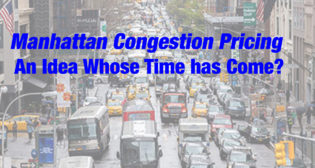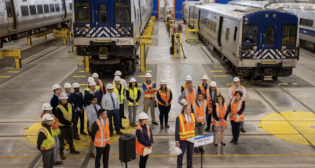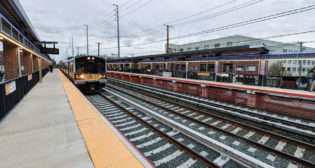
2015 Passenger Rail Outlook
Written by Douglas John BowenStates and cities join those purchasing railcar equipment, often with varied modal needs, prompting fierce competition from industry suppliers eager to serve.
The numbers keep growing. North American rail passenger systems keep multiplying. Their sizes increase. Their fleet numbers keep increasing.
And the number of global equipment suppliers seeking to tap such growth is expanding right along with that.
The numbers counter pessismistic claims that North America’s rail renaissance had run its course in 2014. Indeed, 2014 saw several huge orders for new equipment that added to a backlog of healthy equipment orders from previous years, judging by the numbers of Railway Age’s 2015 Passenger Railcar Outlook.
Such orders, be they from BART on the West Coast (photo above) or MBTA back in the East, were indicative of longstanding commitments by established rail players who have no intention of shrinking their service offerings.
But the old-timers continue to be joined by relative newcomers, often cities moving to establish rail without a corresponding or outside “agency” or “authority” to do so (and prompting complaints about how the Federal Transit Administration assists such city government-driven efforts).
Almost in parallel, well-established and active rail equipment suppliers have found a more crowded playing field as smaller companies, along with Chinese suppliers moving aggressively into the North American market, seek opportunity.
Suppliers’ supple approach
Gone are the days where “build it new” was an axiom, the only option, for suppliers to North American passenger rail entities. While Bombardier continues to work on (and, by at least one report, struggle with) production of 300 new R-179 subway cars for MTA New York City Transit—still the key transit customer on the continent—Kawasaki Heavy Rail Industries is employing a mix-and-match approach for the agency. NYCT is counting on up to 440 R-188 cars to be delivered from Kawasaki’s plant just upstate in Yonkers, N.Y. But those cars, while including brand new end-units for train operators, also will include retrofitting numerous R-142 cars already on the property for several years.
In similar fashion, Kinkisharyo will deliver 35 “mid-section” light rail transit (LRT) units to NJ Transit for use within existing rolling stock serving both the Newark Light Rail and Hudson-Bergen Light Rail lines, to increase passenger capacity. The idea isn’t new: Kinkisharyo already has tackled a similar problem with success for Dallas Area Rapid Transit’s (DART) enhancement of existing LRT rolling stock.
New car orders are still plentiful.Bombardier landed a BART add-on order of 365 rapid transit cars, while China’s CNS Changchun won a Massachusetts Bay Transportation Authority contract to supply 284 rapid transit cars for Boston’s “T” system. MBTA’s contract is likely a harbinger; Oklahoma City in December chose not to accept a low bid from Chinese supplier XEMC for five streetcars, but that bid signaled increased interest by Chinese equipment manufacturers to enter more rail markets. A bid this year by at least one Chinese firm, likely in a joint venture, to manufacture high speed rail (HSR) trains for California looms large, in tandem or competition with familiar players such as Siemens.
Funding continues to flow
Congress’ “Cromnibus” FY15 spending bill cut TIGER spending from $600 million to $500 million, but demand for TIGER funding has always far outstripped supply, meaning the political process for municipalities and transit agencies likely will remain relatively similar, if smaller, to years past, objections from a Republican-controlled Congress notwithstanding.Amtrak retained funding comparable to its FY14 levels, a modest victory given increased sniping at its long-distance service offerings from some corners of Congress. Amtrak seeks to place its own order for new HSR trainsets this year to upgrade its Northeast Corridor service.
Per California’s pending HSR order, suppliers know that states, both individual units and regional compacts, are stepping in more often when the federal government’s disinterest thwarts a purchase. During 2014, California and several Midwest states told carbuilder Nippon Sharyo to add
45 bi-level intercity cars to their existing 130-car order. California will add 11 cars to its initial 42-car order, and
the Midwest states will boost their 88-car order by 34 cars.
Streetcar moves, pro and con
Notwithstanding crocodile-tears reporting from various media over U.S. streetcar prospects as 2014 ended, the market for the rail submode seems to be growing, not shrinking. As just two examples, Oklahoma City is close
to ordering five streetcars in 2015 from one of numerous suppliers bidding for the city’s business, with an option for eight additional cars. Meanwhile, track-gauge woes notwithstanding, construction of Charlotte, N.C.’s Phase 1 streetcar project is well under way, with Phase 2 getting approval last year from the FTA.
Looming as real possibilities are numerous streetcar orders, including but not limited to Anaheim and Santa Ana, Calif., both Miami and Miami Beach, as well as St. Augustine, Fla., Grand Rapids, Mich., Minneapolis and St. Paul, Minn., Winston-Salem, N.C., Providence, R.I., and El Paso, Tex. Other efforts, including those in Fort Lauderdale, Fla., and even a decades-long effort in Milwaukee, seem poised to become reality. It’s likely many of these efforts will stall or fall. But all of them?
To be sure, pushback from taxpayers and NIMBYs killed off or threatened numerous LRT and streetcar proposals in 2014, with particular attention given to a triad of D.C.-area projects: Arlington’s two proposed streetcar projects, the Purple Line light rail transit project spanning two Maryland counties northeast of Washington, and the District’s slow-to-open streetcar line on H Street. Media seized on the killing, threatening, and tardiness of the trio, flirting with the conclusion that U.S. urban rail transit growth had peaked.
D.C.-area projects were not the only casualties. San Antonio anti-rail forces succeeded in scuttling a nascent streetcar project, while voters in Tampa Bay rejected the latest effort to advance light rail transit. And fumbles, described by some as ineptitude, put the proposed St. Louis Loop trolley project on the brink of dismissal.
Those developments proved that the woebegone news generated within the Beltway did reflect reality, at least in part. But such setbacks failed to encompass the full breadth of U.S. rail passenger progress. Case in point: As San Antonio’s streetcar plan faltered, few seemed to notice that El Paso’s efforts were still ongoing.



